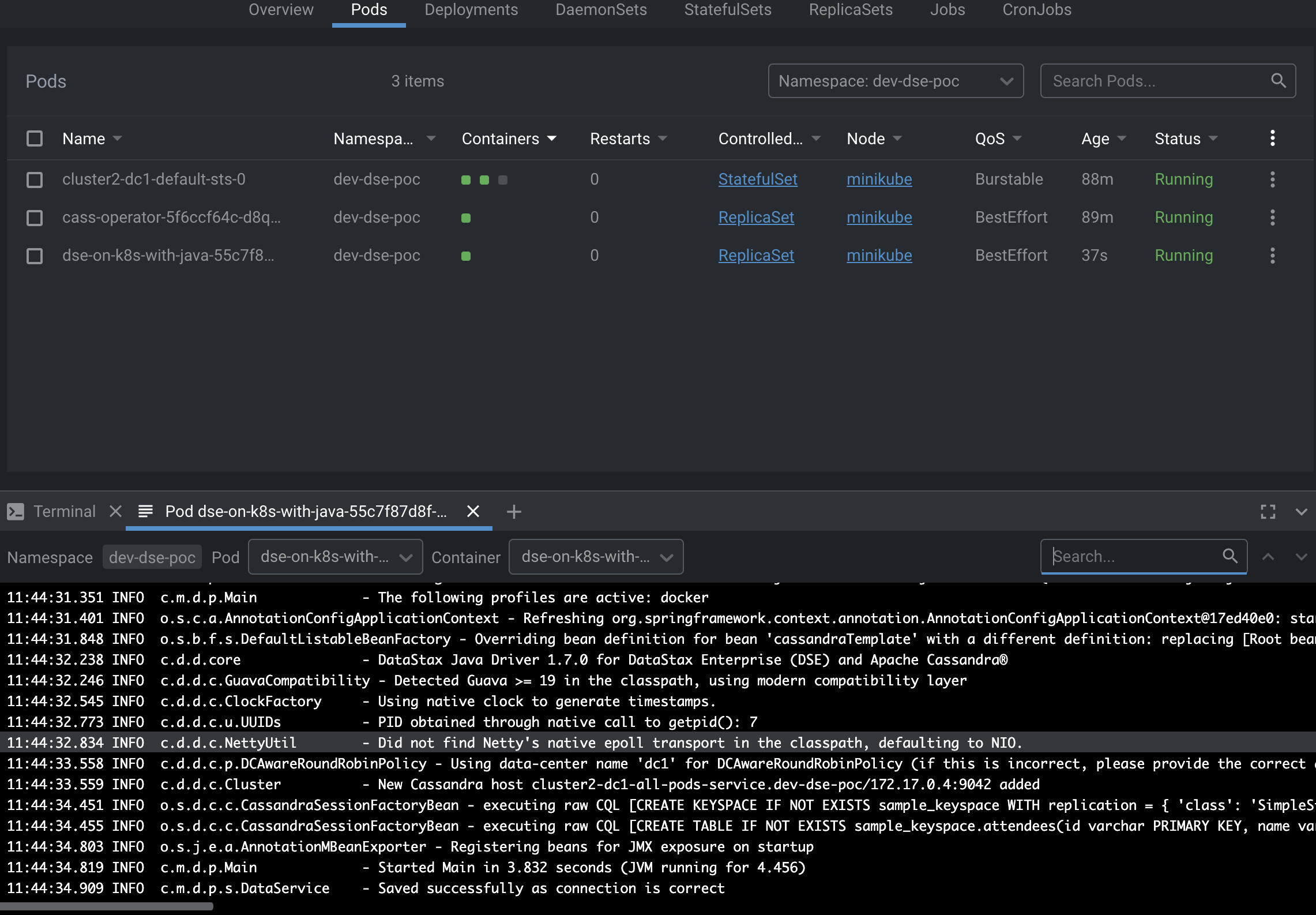1. Introduction
DataStax Enterprise (DSE) version 6.8 a hybrid cloud, that is can run on-premises or across regions on the cloud to give all the capabilities of Apache Cassandra with enterprise tooling and expert support. In this particular concept it will be deployed on AWS. Specifically EKS.
2. Setting Up DSE Cluster on EKS
To set up a simple DSE cluster.
- DSE version :
DSE 6.8.4 - EKS :
1.21
a. Download file https://github.com/malike/dse-on-k8s-with-java.git.
b. cd into the deployment directory of the repository.
c. Run make install-cass-operator to deploy the Cass Operator and also create the namespace dev-dse-poc. The Cass Operator includes resources for the following:
- ServiceAccount, Role, and RoleBinding to manage permissions necessary to run the operator.
- CustomResourceDefinition (CRD) for the CassandraDatacenter resources used to set up the clusters managed by Cass Operator.
- Deployment parameters to ensure the operator runs well.
kubectl -n dev-dse-poc get poto confirm the operator is running.
1
2
NAME READY STATUS RESTARTS AGE
cass-operator-848fb7cd47-r5r6m 1/1 Running 0 2h
e. Create EBS StorageClass resource with the command make create-ebs-storage. This will create a StorageClass with the definition.
1
2
3
4
5
6
7
8
9
10
apiVersion: storage.k8s.io/v1
kind: StorageClass
metadata:
name: server-storage
provisioner: kubernetes.io/aws-ebs
parameters:
fsType: ext4
type: gp2
reclaimPolicy: Delete
volumeBindingMode: WaitForFirstConsumer
If you’re testing on minikube the StorageClass will not work for you. You should use something like this below
1
2
3
4
5
6
7
apiVersion: storage.k8s.io/v1
kind: StorageClass
metadata:
name: server-storage
provisioner: k8s.io/minikube-hostpath
reclaimPolicy: Delete
volumeBindingMode: Immediate
The values can be customized based on need.
Verify the StorageClass is running perfectly.
kubectl -n dev-dse-poc get storageclass
1
2
3
NAME PROVISIONER RECLAIMPOLICY VOLUMEBINDINGMODE ALLOWVOLUMEEXPANSION AGE
gp2 (default) kubernetes.io/aws-ebs Delete WaitForFirstConsumer false 5d
server-storage kubernetes.io/aws-ebs Delete WaitForFirstConsumer false 2h
f. Create cluster and datacenters parameters with make create-data-center.
1
2
3
4
5
6
7
8
9
10
11
12
13
14
15
16
17
18
19
20
21
22
23
24
25
26
27
apiVersion: cassandra.datastax.com/v1beta1
kind: CassandraDatacenter
metadata:
name: dc1
spec:
clusterName: cluster2
serverType: dse
serverVersion: "6.8.4"
managementApiAuth:
insecure: { }
size: 3
storageConfig:
cassandraDataVolumeClaimSpec:
storageClassName: server-storage
accessModes:
- ReadWriteOnce
resources:
requests:
storage: 5Gi
config:
jvm-server-options:
initial_heap_size: "1G"
max_heap_size: "1G"
max_direct_memory: "1G"
additional-jvm-opts:
- "-Ddse.system_distributed_replication_dc_names=dc1"
- "-Ddse.system_distributed_replication_per_dc=3"
This is a single datacenter with 1 rack, and 3 nodes.
Verify the datacenter is running by running kubectl -n dev-dse-poc get po
1
2
3
4
5
NAME READY STATUS RESTARTS AGE
cass-operator-848fb7cd47-r5r6m 1/1 Running 0 2h
cluster2-dc1-default-sts-0 2/2 Running 0 2h
cluster2-dc1-default-sts-1 2/2 Running 0 2h
cluster2-dc1-default-sts-2 2/2 Running 0 2h
An output similar to this with all 4 pods running confirms a successful installation of DSE. One pod is for the CassOperator, which helps manage the lifecycle of the DSE cluster, the other 3 pods.
Note that for setting up the DataCenter, racks must have identifiers. The number of racks created can not easily be changed. The number of racks should match the replication factor in the keyspaces you plan to create.
Define the storage parameters Define the storage with a combination of the previously provisioned storage class and size parameters. These values inform the storage provisioner how much room to require from the backend.
3. Accessing The DSE Cluster with our Sample Java Application
To access the DSE data center we’ll need to get the credentials. By default, Cass Operator creates a Cassandra superuser. A Kubernetes secret is created, named
kubectl get secret cluster2-superuser -n dev-dse-poc -o yaml
1
2
3
4
5
6
7
8
9
10
11
12
13
14
15
16
17
apiVersion: v1
data:
password: base64-encoded-password
username: base64-encoded-username
kind: Secret
metadata:
annotations:
cassandra.datastax.com/watched-by: '["dev-dse-poc/dc1"]'
creationTimestamp: "2021-10-12T10:35:28Z"
labels:
cassandra.datastax.com/watched: "true"
name: cluster2-superuser
namespace: dev-dse-poc
resourceVersion: "6901797"
selfLink: /api/v1/namespaces/dev-dse-poc/secrets/cluster2-superuser
uid: 0befbdd3-df81-4527-a2af-05af64fe0b06
type: Opaque
The source code is available here https://github.com/malike/dse-on-k8s-with-java.git
Then we deploy by executing the goal make deploy-app.

4. Other Tools to manage the Cluster.
There are additional opensource tools to take advantage of to manage our cluster aside from the CassOperator. For example:
i. management-api-for-apache-cassandra, which provides a sidecar service layer that provides a set of operational actions on Cassandra nodes that can be administered. This is in use by the CassOperator as well.
ii. reaper-operator which helps to schedule and orchestrate repairs of Apache Cassandra clusters
iii. medusa-operator which helps manage backup/restore capabilities for Apache Cassandra
